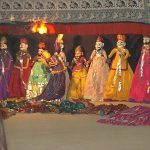String Puppets
- Features
- The puppets are generally eight to nine inch miniature figures chiselled out of wood.
- Oil paint is used to paint the wood initially and to add other facial features such as eyes, lips, nose, etc.
- Small wooden pipes are created with the body to form the limbs. The body is then covered with colourful miniature dress and stitched.
- Miniature jewelleries and other accessories are attached to give it a trueto-life feel.
- Strings are attached to small holes in the hands, head and back of the body which are then controlled by the puppeteer.
- Example: Kathputli , Rajasthan
Shadow Puppets
- Features
- Shadow puppets are flat figures cut out of leather.
- The figures are painted identically on both sides of the leather.
- The puppets are placed on a white screen with light falling from behind, creating a shadow on the screen.
- The figures are manipulated so that the silhouettes created on the blank screen create telling imagery.
- Example: Ravanachhaya, Odisha
Rod Puppets
- Features
- Uses rods to control puppets.
- Large and elaborately decorated.
- Allows expressive and forceful movements.
- Themes from mythology and folklore
- Includes live music and narration.
- Prominent in Eastern India (West Bengal, Odisha, Bihar).
- Visually striking and dynamic.
- Requires more space and skill.
- Example: Putul Nach, West Bengal
Glove Puppetry
- Features
- Uses glove-like puppets worn on the hand.
- Also called hand puppetry or palm puppetry.
- Puppeteer controls head and arms with fingers.
- Often depicts stories from epics like Ramayana.
- Combines dance, music, and storytelling.
- Puppets made of wood, cloth, or papier-mâché.
- Portable and performed in small spaces.
- Used to spread social and moral messages.
- Example: Pavakoothu, Kerala


